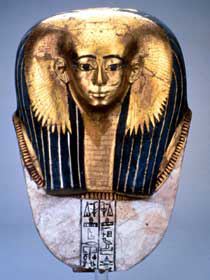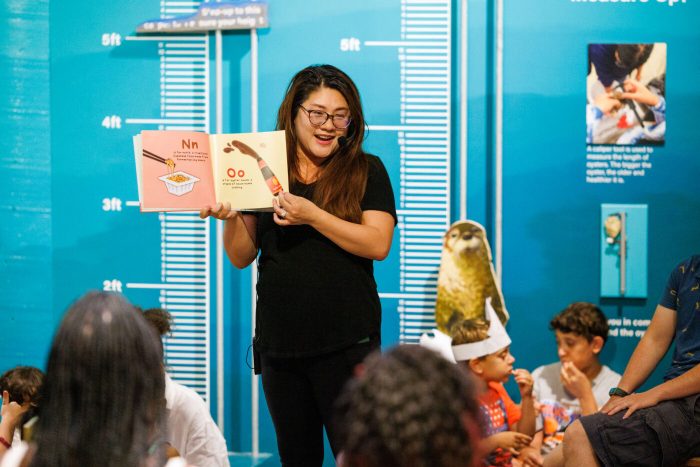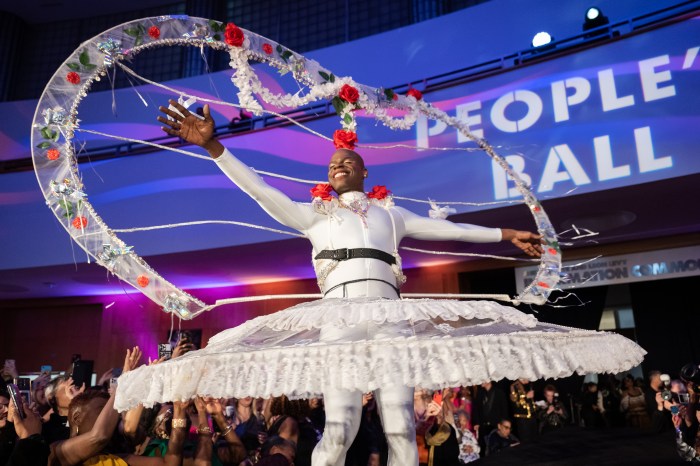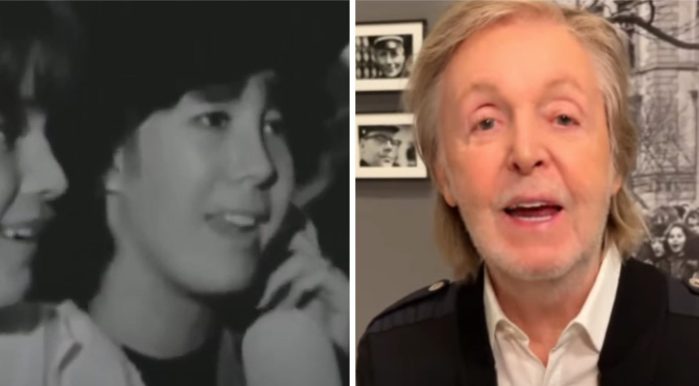The Brooklyn Museum of Art’s current showcase
of treasures, "Eternal Egypt: Masterworks of Ancient Art
from the British Museum," focuses on the unique artistic
style that is the ancient culture’s enduring legacy. It also
complements the museum’s own extensive collection of Egyptian
artifacts.
"Eternal Egypt" is not only enormous in scope – it
covers 3,000 years of Egyptian art history – but many of the
pieces themselves are monumental in size and lit to their greatest,
most imposing effect by exhibition designer Charles Froom.
"Eternal Egypt" enables the viewer to effortlessly
absorb and glory in thousands of years of Egyptian art history
– all the while marveling at the expansive collection assembled
by the British Empire.
While the touring works of art are from the British Museum (which
is currently undergoing renovations), and the exhibition was
organized by both the American Federation of the Arts and the
British Museum, this exhibit is curated by the Brooklyn Museum’s
Edna Russmann, curator of Egyptian, Classical and ancient Middle
Eastern art.
Russmann has also written the fascinating catalogue for the exhibition
(University of California Press, $39.95, paperback); however,
it must be said that the enormous size of many of the pieces
can’t be appreciated in the pages of a catalogue. Brooklynites
should take advantage of the two-month-long opportunity to experience
these massive pieces in person.
There’s the monumental 2.5-ton, larger-than-life-size red granite
lion from the temple of Amenhotep III (1390-1352 BC), which is
certainly a show stopper, rivaled by the colossal head of Amenemhat
III (1854-1808 BC) which is carved of granite and is also displayed
on top of a tall pedestal. Another imposing carving is the column
capital with the Hathor emblem from the temple of Bastet (924-850
BC). Originally this 46-inch tall red granite portrait of the
goddess was the top of one of four columns.
The exhibition also features numerous exquisite smaller works.
All 17 inches of the sensuous, curving statue of a woman carved
from luminous Egyptian alabaster (2613-2566 BC) glows from within
a case. Then there is the fist-sized bust of a man’s shaven head
(1795-1650 BC). Carved from sandstone, the color of a gingersnap,
his heavy lidded eyes, high cheekbones and enigmatic smile make
for an entrancing portrait.
What is most revealing in this exhibit – more than the constants
in Egyptian art such as the solid, block-like form and the placid,
Buddha-like expression on the regal faces – are the differences
the viewer begins to discern. Because of the number of pieces
in the exhibit, revealing comparisons can be made and the subtle
changes in Egyptian art over time unfold in successive rooms.
(The exhibit is mounted in chronological order.) Statues are
carved from a variety of stone – brownstone, sparkling mottled
stones, and brown-and-white swirled quartzite – such as the enormous
head of Amenhotep III (circa 1390-1352 BC) – that looks as though
it was smoothly poured from a soft serve ice cream machine.
The viewer can appreciate not only the different styles of statue
carvings and tomb wall carvings, but also how Egyptian style
itself evolved. Examine the hairstyles (the wigs, the braided
cornrows, the beads, the wavy hair bound at the ends) and the
jewelry (bracelets and anklets, large earrings, fine small gold
earrings). The gold cowrie shells in one necklace are a precursor
to the cowrie shells worn in necklaces and in the hair of some
Brooklynites today. (The exhibition notes explain those cowrie
shells were symbols worn to safeguard female fertility.)
There’s even a wide variety of clothing styles featured in the
carvings – from the simple sheath garments to the later, pleated
tunics – a predecessor to Japanese fashion designer Issey Miyake’s
creations.
And it wasn’t just the clothing of women that showed such variety.
The statue of Ptahemsaf, circa 1795-1650 BC, depicts the man
in a long kilt wrapped around his body, as one would wrap a bath
towel – except this one covers him from breast to calf. The curator
notes explain that the linen was folded and stored in a chest
and these creases are "realistically" carved into the
sculpture. Another standing cloaked male figure (circa 1880-1808)
with his domed wig carved from mottled black granite seems the
inspiration for the costume of Darth Vader.
A major highlight of this 140-piece show, which includes statues,
reliefs, gold jewelry and funerary objects, is the room of "Book
of the Dead" papyrus rolls, including three from the "celebrated
19th Dynasty papyrus of Ani." The "Book of the Dead"
is the modern name for an ancient Egyptian collection of mortuary
texts made up of spells or magic formulas, placed in tombs and
believed to protect and aid the deceased in the hereafter.
"Ani’s Judgement" in particular depicts a harrowing
scene. According to the exhibit notes, before Ani, a king’s scribe,
could pass into the Afterlife, he faced a "moment of truth."
In this scroll Ani watches while Anubis weighs his heart on a
scale against a feather (representing "Maat," truth
and order). To the right is a monster "ready to spring forward
to consume Ani’s heart if he fails to pass the test." Even
without the ability to read the hieroglyphics, a viewer can recognize
the gravity of Ani’s situation.
There are also in-progress wall carvings on display such as the
unfinished stela of the sculptor Userwer (circa 1985-1795 BC).
The grid and outlines of the forms drawn hint at the painstaking,
laborious process of making these sunken relief carvings of perfectly
proportioned figures.
"Eternal Egypt" stretches on and on for rooms and rooms
on the fifth floor with it’s only jarring moment being an interruption
by the Francois Auguste Rodin (1840-1917) sculpture court.
The Brooklyn Museum is the only venue in the Northeast showing
"Eternal Egypt," encompassing the entire period of
pharaonic history from the First Dynasty, into the first centuries
of the Roman conquest of Egypt. The works have the power to entrance
and capture the imagination of the viewer who stands on another
continent, across an ocean, 5,000 years later. That is as monumental
as the pieces themselves.
"Eternal Egypt: Masterworks of
Ancient Art from the British Museum" will be on display
through Feb. 24 at the Brooklyn Museum of Art [200 Eastern Parkway,
(718) 638-5000]. On Saturday Jan. 5, during the First Saturday
event from 6 pm to 11 pm, the exhibit, without the audio tour,
will be free of charge. On other days, ticket prices for the
exhibit, which include the audio tour, are $10 adults, $8 students
and $4 children ages 6 to 12.























